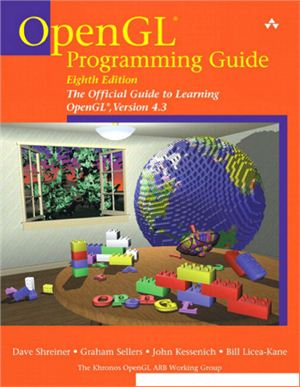Addison-Wesley, 2013. - 935 p. (8th Edition)
Лучшая книга по OpenGL переиздана. Книга переписана практически на
100%. Из нее удалено описание множества устаревших технологий и
дано описание новых, введенных стандартом OpenGL
4.3. Дано полное объяснение языка шейдеров GLSL, ранее описанное в оранжевой книге OpenGL. В книге также приведено множество интересных примеров использования OpenGL. Today’s OpenGL software interface enables programmers to produce extraordinarily high-quality computer-generated images and interactive applications using 2D and 3D objects, color images, and programmable shaders.
OpenGL® Programming Guide: The Official Guide to Leaing OpenGL®, Version 4.3, Eighth Edition, has been almost completely rewritten and provides definitive, comprehensive information on OpenGL and the OpenGL Shading Language. This edition of the best-selling Red Book describes the features through OpenGL version
4.3. It also includes updated information and techniques formerly covered in OpenGL® Shading Language (the Orange Book).
For the first time, this guide completely integrates shader techniques, alongside classic, functioncentric techniques. Extensive new text and code are presented, demonstrating the latest in OpenGL programming techniques.
OpenGL® Programming Guide, Eighth Edition, provides clear explanations of OpenGL functionality and techniques, including processing geometric objects with vertex, tessellation, and geometry shaders using geometric transformations and viewing matrices; working with pixels and texture maps through fragment shaders; and advanced data techniques using framebuffer objects and compute shaders.
New OpenGL features covered in this edition include
Best practices and sample code for taking full advantage of shaders and the entire shading pipeline (including geometry and tessellation shaders)
Integration of general computation into the rendering pipeline via compute shaders
Techniques for binding multiple shader programs at once during application execution
Latest GLSL features for doing advanced shading techniques
Additional new techniques for optimizing graphics program performance
4.3. Дано полное объяснение языка шейдеров GLSL, ранее описанное в оранжевой книге OpenGL. В книге также приведено множество интересных примеров использования OpenGL. Today’s OpenGL software interface enables programmers to produce extraordinarily high-quality computer-generated images and interactive applications using 2D and 3D objects, color images, and programmable shaders.
OpenGL® Programming Guide: The Official Guide to Leaing OpenGL®, Version 4.3, Eighth Edition, has been almost completely rewritten and provides definitive, comprehensive information on OpenGL and the OpenGL Shading Language. This edition of the best-selling Red Book describes the features through OpenGL version
4.3. It also includes updated information and techniques formerly covered in OpenGL® Shading Language (the Orange Book).
For the first time, this guide completely integrates shader techniques, alongside classic, functioncentric techniques. Extensive new text and code are presented, demonstrating the latest in OpenGL programming techniques.
OpenGL® Programming Guide, Eighth Edition, provides clear explanations of OpenGL functionality and techniques, including processing geometric objects with vertex, tessellation, and geometry shaders using geometric transformations and viewing matrices; working with pixels and texture maps through fragment shaders; and advanced data techniques using framebuffer objects and compute shaders.
New OpenGL features covered in this edition include
Best practices and sample code for taking full advantage of shaders and the entire shading pipeline (including geometry and tessellation shaders)
Integration of general computation into the rendering pipeline via compute shaders
Techniques for binding multiple shader programs at once during application execution
Latest GLSL features for doing advanced shading techniques
Additional new techniques for optimizing graphics program performance

